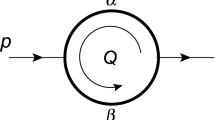Abstract
The double exponential (DE) formulas for numerical integration are known to be highly efficient, more efficient than the single exponential (SE) formulas in many cases. Function classes suited to the SE formulas have already been investigated in the literature through rigorous mathematical analysis, whereas this is not the case with the DE formulas. This paper identifies function classes suited to the DE formulas in a way compatible with the existing theoretical results for the SE formulas. The DE formulas are good for more restricted classes of functions, but more efficient for such functions. Two concrete examples demonstrate the subtlety in the behavior of the DE formulas that is revealed by our theoretical analysis.
Similar content being viewed by others
References
Bornemann F., Laurie D., Wagon S., Waldvogel J.: The SIAM 100-digit challenge. SIAM, Philadelphia (2004)
Davis P.J., Rabinowitz P.: Methods of Numerical Integration, 2nd edn. Academic Press, New York (1984)
Iri M., Moriguti S., Takasawa Y.: On a certain quadrature formula. RIMS Kokyuroku Kyoto Univ. 91, 82–119 (1970) (in Japanese)
Iri M., Moriguti S., Takasawa Y.: On a certain quadrature formula. J. Comput. Appl. Math. 17, 3–20 (1987) (translation of the original paper [3]
Mori M., Sugihara M.: The double exponential transformations in numerical analysis. J. Comput. Appl. Math. 127, 287–296 (2001)
Muhammad M., Mori M.: Double exponential formulas for numerical indefinite integration. J. Comput. Appl. Math. 161, 431–448 (2003)
Sag W.T., Szekeres G.: Numerical evaluation of high-dimensional integrals. Math. Comp. 18, 245–253 (1964)
Schwartz C.: Numerical integration of analytic functions. J. Comput. Phys. 4, 19–29 (1969)
Stenger F.: Integration formulas based on the trapezoidal formula. J. Inst. Math. Appl. 12, 103–114 (1973)
Stenger F.: Approximations via Whittaker’s cardinal function. J. Approx. Theory 17, 222–240 (1976)
Stenger F.: Numerical Methods Based on Sinc and Analytic Functions. Springer, New York (1993)
Stenger F.: Summary of Sinc numerical methods. J. Comput. Appl. Math. 121, 379–420 (2000)
Sugihara M.: Optimality of the double exponential formula—functional analysis approach. Numer. Math. 75, 379–395 (1997)
Takahasi H., Mori M.: Quadrature formulas obtained by variable transformation. Numer. Math. 21, 206–219 (1973)
Takahasi H., Mori M.: Double exponential formulas for numerical integration. Publ. RIMS Kyoto Univ. 9, 721–741 (1974)
Author information
Authors and Affiliations
Corresponding author
Rights and permissions
About this article
Cite this article
Tanaka, K., Sugihara, M., Murota, K. et al. Function classes for double exponential integration formulas. Numer. Math. 111, 631–655 (2009). https://doi.org/10.1007/s00211-008-0195-1
Received:
Revised:
Published:
Issue Date:
DOI: https://doi.org/10.1007/s00211-008-0195-1



